-
Paper Information
- Paper Submission
-
Journal Information
- About This Journal
- Editorial Board
- Current Issue
- Archive
- Author Guidelines
- Contact Us
Journal of Mechanical Engineering and Automation
p-ISSN: 2163-2405 e-ISSN: 2163-2413
2017; 7(1): 16-22
doi:10.5923/j.jmea.20170701.03

Sled Damping Seat to Decrease Neck Injury in Rear-end Accident Experimental and Modelling
K. Alhaifi , N. Alhaifi , J. Alazemi, J. Alrajhi, A. Abed
Department of Automotive & Marine Engineering, Collage of Technological Studies, Public Authority of Applied Education and Training, Kuwait
Correspondence to: K. Alhaifi , Department of Automotive & Marine Engineering, Collage of Technological Studies, Public Authority of Applied Education and Training, Kuwait.
| Email: |  |
Copyright © 2017 Scientific & Academic Publishing. All Rights Reserved.
This work is licensed under the Creative Commons Attribution International License (CC BY).
http://creativecommons.org/licenses/by/4.0/

Neck injuries caused by rear end collisions have become a major problem in traffic safety over the last two decades. This situation calls for more research in the field. One area of interest is a damping seat slide to reduce neck injury. To reduce neck injury (Whiplash), based upon new biomechanical research, the motion between head and torso should be reduced. In case of a rear end impact new seat will slide backwards during the impact which allows the motion to damp. Working Model software was used first to simulate and analyse the behaviour of the new system, also a test rig was developed for experimental purposes. The results show occupant protection increases with the new damping seat slide by reducing the NIC 35%.
Keywords: Neck injuries, Rear collisions, Whiplash, Damping seat, Modelling
Cite this paper: K. Alhaifi , N. Alhaifi , J. Alazemi, J. Alrajhi, A. Abed , Sled Damping Seat to Decrease Neck Injury in Rear-end Accident Experimental and Modelling, Journal of Mechanical Engineering and Automation, Vol. 7 No. 1, 2017, pp. 16-22. doi: 10.5923/j.jmea.20170701.03.
Article Outline
1. Introduction
- Rear-end car collision typically occur in traffic situation with dense traffic and relatively small distances between vehicles in the small lane. Rear-end collisions often result in neck injuries to the occupants of the struck car. During the collision the vehicle is subjected to a forceful forward acceleration and the car occupants are pushed forward by the seat-backs. The head lags behind due to its inertia forcing the neck into a swift extension (rearward binding) motion. This head motion continues until the neck reaches the end of its motion range or, hits a head restraint or some other structure behind the head. From this point on, the head moves forward and stops in a somewhat flexed (forward bent) neck posture. This type of swift injurious extension-flexion motion of the neck [1] and is commonly called "Whiplash motion".Neck injuries in rear-end collisions mostly occur at very low impact velocities, typically less than 20 Km/h [2, 3] and are mostly classified as minor injury (AIS 1) on the abbreviated injury scale [4-6] since the scale classifies injuries according to fatality risk. [7] Suggested that the elastic rebound of the seat back could be an aggravating factor for the whiplash extension motion. The rebound of the seat back can push the torso forward relative to the vehicle at an early stage of the whiplash extension motion when the head begins rotating rearward. This in turn increases the relative linear and angular velocity of the head relative to the upper torso at the same time as it delays contact between the head and head-restraint, thus causing a larger maximum extension angle. Subsequent studies support this theory [8-11]. If the seat back of the front seat collapse or yields plastically during a rear-end collision, the elastic seat back rebound is likely to be reduced.To date, the underlying injury mechanism has not yet been established. Several hypotheses have been suggested by various researchers, but are not conclusive. It seams to be generally agreed upon the fact that such injury is related to sudden movement of the head-torso complex [12].
2. Seat Design
- Several seat systems are presented to prevent whiplash injury. Volvo presented the WHIPS seat [13] which is equipped with a recliner that allows controlled backward movement of the backrest during rear-end impact. The motion is performed in two steps: a translational rearwards movement of the backrest is followed by a rotational motion reclining the backrest. Another system, called WipGARD [14], also enables the backrest to perform a translation followed by a rotation. Both the WHIPS and the WipGARD require a critical load to activate the system. The Saab active head restraint (SAHR) system [15], for instance, consists of an active head restraint that automatically moves up and closer to the occupant's head in rear-end impacts. Thus the distance between the head restraint and the head is reduced. The third system is Cervical Spine Distortion injuries (CSD), and the functional principle of the CSD system is based on a defined energy absorption in the backrest. This principle has been employed successfully for a number of years. In standard series seats, the deformation element is located in the recliner. During rear impact, a parallel backwards movement of the seat back begins at a point of critical load, which motion is then transformed into rotation [16]. The backwards movement is limited so that the seat back will offer sufficient protection in a high-speed rear impact.
3. Linear Damping Seat
- A Linear Damping Seat (LDS) to reduce or prevent neck injury is presented in this research. The concept, though the mechanism of whiplash injuries is not completely understood, a decrease in neck motion is thought to lessen whiplash injuries. Expressing the above ideas visually, figure 1. shows the concept for reducing the likelihood of whiplash injuries or lessening the severity. Also this study was evaluate the properties of a seat independently of the corresponding car structure. The new linear damping seat (LDS) designed to prevent or reduce whiplash injury was developed. The uniqueness of this design is that the arrangement contains a seat which will move in a controlled manner against the direction of movement during a change in velocity, and that the seat is provided with guidance devices which are intended to give the seat and the person sitting in it a linear movement against the direction of movement.
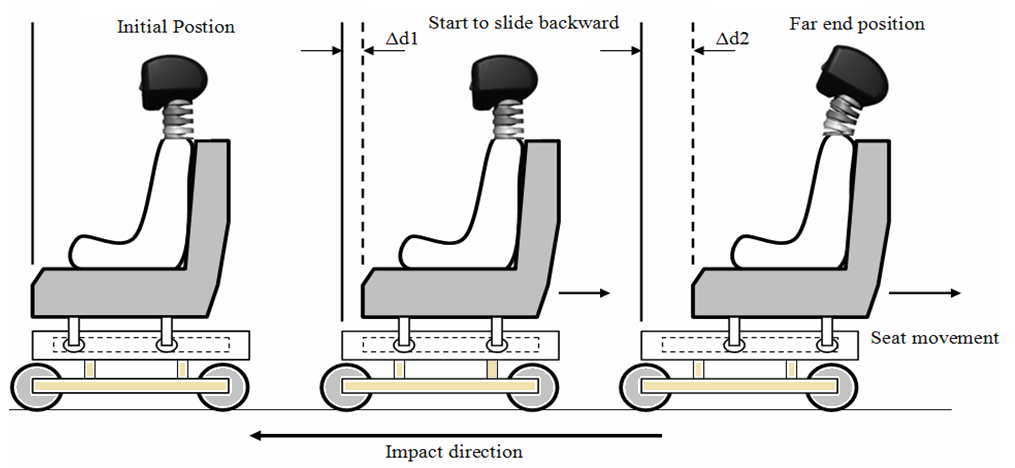 | Figure 1. Linear damping seat during rear-ends impact |
4. Experiment Details
- The Working Model dynamic simulation program was used to study the effect of stander seatback compared with Linear Damping seat during the rear-end impact. To analyze whether the new linear damping seat offers the possibility of preventing neck injuries, sled test were performed. The sled test rig (figure 2) was design and developed to validate the simulation model and to be flexible for different verity of rear-end impact test such as head restraint position or seatback stiffness [17].
 | Figure 2. Sled pendulum facilities used to simulate rear end impact loading to head and neck complex |
5. Experimental Results
- The reference seat (RS) is a production seat without head restraint. Also, the reference seat term was used to describe the head and neck complex fixed on the seat base directly with no seat (as described in chapter three). Rear impact sled tests are obtained for the both reference seat and reference seat with head-neck complex (Hybrid neck III). The test results show head acceleration with time for different collision conditions.Experiment results in figure (3) show that head acceleration peak value for LDS decreases by approximately 28% as compared with RS at 14km/h speed and 4g acceleration. As impact speed increased head acceleration increased as shown in figure (4) and (5) [17].
|
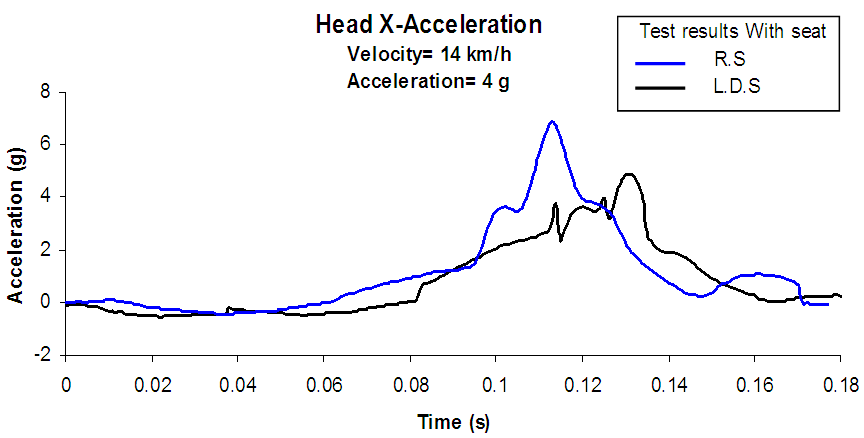 | Figure 3. Test results comparison between RS and LDS with seat at 14km/h-4 g |
 | Figure 4. Test results comparison between RS and LDS with seat at 8km/h-4 g |
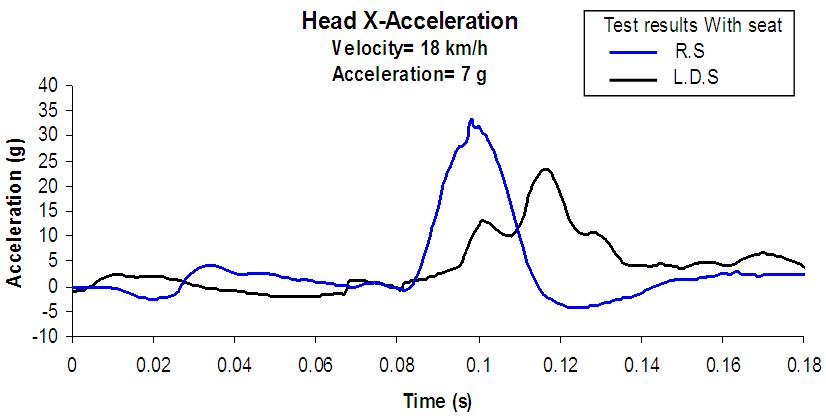 | Figure 5. Test results comparison between RS and LDS with seat at 18km/h-7 g |
 | Figure 6. Sled test head acceleration peaks results comparison between LDS and RS (with seat) |
6. Computer Model Description
- The MSC.visualNastran 4D (vN4D) 2003 is a software simulation tool for the dynamic evaluation of rigid bodies and motion analysis. It takes mechanical or biomechanical simulation to the next dimension by merging CAD, motion, FEA, and controls technologies into a single functional modeling system. The head-neck model geometry was first built by using Solid Edge 11 software package, and then it was imported (interfaced) to MSC.vN4D software. The head-neck model was designed to be simple, in terms of design, number of parts, control and simulation in order to smooth the progress of transferring the parts from the mathematical model into mechanical components. Figure 7 shows the movements of the head-neck complex during rear-end impact and it illustrates the first phase.
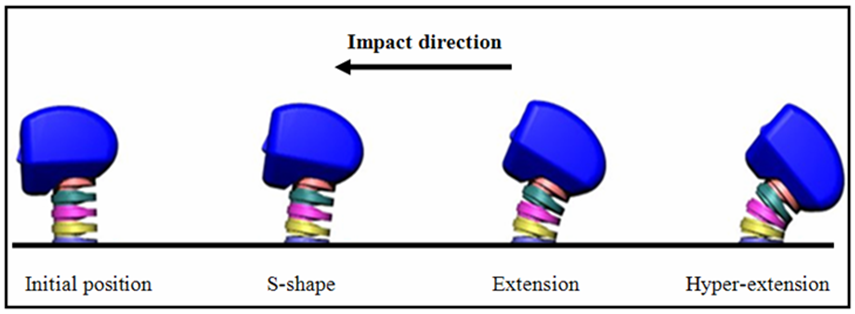 | Figure 7. Kinematics of the head-neck computer model during rear-end impact using (VN4D software) |
7. Modelling Results
- The same test condition procedures were followed for the computer model as for the sled tests. The general response of the computer model simulation is shown in Figure 8. The head acceleration and the peak time from the sled tests and computer model have been shown in the Figures 5-10 and 11. The computer model response shows similar head-neck response until approximately 200 ms and in that time the rebound stage starts, which is not covered in this study. For the RS (with seat) the head acceleration peaks were recorded between 90-120 ±15 ms for the experimental and modelling results (Figures 5-10 and 11). The results from the computer model are very close to those from the sled tests; for the acceleration peak values and the time when the acceleration peak values occurred are a little different. This occurred because the computer model was used to reproduce a rear-end impact with a wide range of different impact velocities and accelerations to simulate the different sled test conditions. Figure 9 shows the comparisons of head peak accelerations between sled test and computer model using RS.
 | Figure 8. Example of a computer model from this thesis of dynamic response during rear-end impact (RS) |
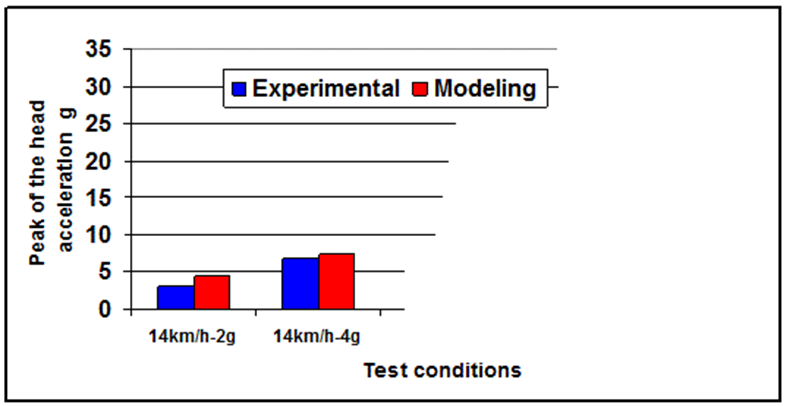 | Figure 9. Comparison between sled test and computer model results for the RS with seat with respect to head acceleration peaks |
8. Discussion
- The same test condition has been applied to the head-neck complex on tests with and the reference car seat. The results from sled tests are shown above. Each sled test has been repeated three times and the average result has been used in this study. The effect of the seat can be clearly seen by comparing the results for the head acceleration peaks. In addition, Figure 10 and 11 shows the results of the computer modelling.
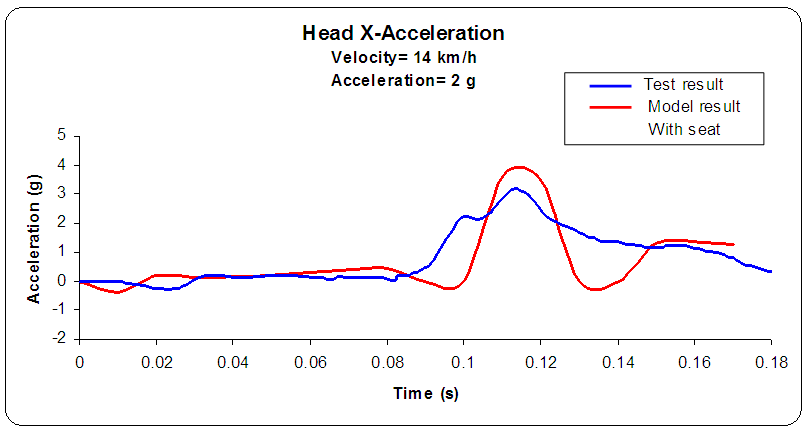 | Figure 10. Comparison between test and computer model results for the RS with seat at impact speed = 14 km/h and trolley peak acceleration = 2 g |
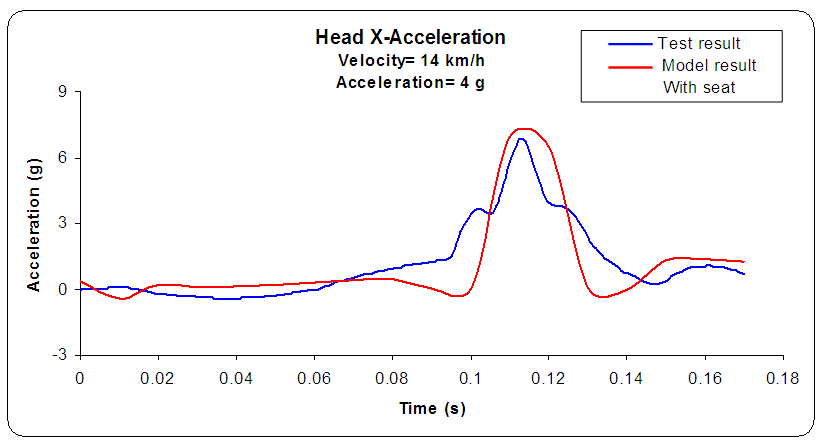 | Figure 11. Comparison between test and computer model results for the RS with seat at impact speed = 14 km/h and trolley peak acceleration = 4 g |
9. Conclusions
- The new Linear Damping Seat design for reduction in whiplash injuries, allows less motion between head and torso as shown in the experimental results (trail sled tests) and the modelling results, linear damper shows lessen the movement of the neck (spring) extension.
 Abstract
Abstract Reference
Reference Full-Text PDF
Full-Text PDF Full-text HTML
Full-text HTML